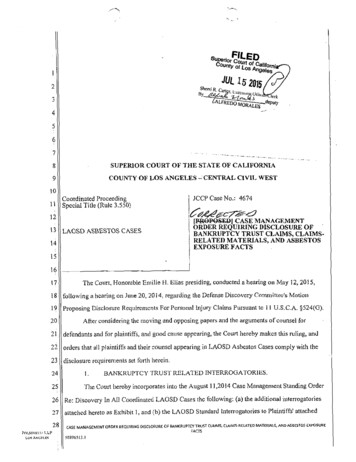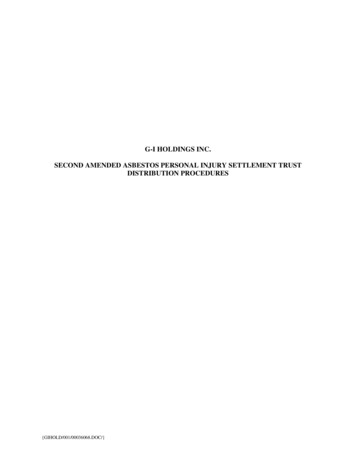
Transcription
Baby BondsParenting, attachment and a secure base for childrenResearch by Sophie Moullin, Jane Waldfogel and Elizabeth WashbrookMarch 20141
CONTENTSFOREWORD . . .3EXECUTIVE SUMMARY . 4RECOMMENDATIONS . 61. INTRODUCTION . 72. WHAT IS ATTACHMENT? . 92.1 Types of attachment & prevalence . 93. HOW DOES SECURE ATTACHMENT DEVELOP? . 113.1 Psychosocial pathways . 113.2 Biological and neurological pathways . 113.4 Attachment to whom? . 124. WHY DOES ATTACHMENT MATTER? . 134.1 Attachment disorders . 134.2 Social and emotional development . 134.3 Cognitive and language development . 144.4 Attachment as a protective factor . 154.5 Health outcomes . 154.6 Longer-term effects of attachment. 155. WHAT ARE THE RISK FACTORS FOR INSECURE ATTACHMENT? . 175.1 Poverty. 175.2 Mental health . 175.3 Young parenting . 185.4 Disabilities. 185.5 Low-quality early childcare . 186. HOW CAN POLICY PROMOTE SECURE ATTACHMENT? . 206.1 Reducing risk factors . 206.2 Intervening early . 216.3 The Family-Nurse Partnership . 236.4 The Incredible Years – Training for Babies, Toddlers and Parents . 236.5 Circle of Security . 246.6 Child-Parent Psychotherapy (CPP) . 246.7 Minding the Baby . 256.8 Reflective Parenting (Piloted by Parents Early Education Partnership (PEEP)) . 256.9 The Oxford Parent Infant Project (OXPIP) . 256.10 Policy mix, costs and delivery . . .267. CONCLUSIONS . 28AKNOWLEDGEMENTS . . 29APPENDIX 1 .30APPENDIX 2 .32REFERENCES . 332
FOREWORDImproving social mobility through education is the goal of the Sutton Trust. Whilst we may bebetter known for our focus on access to university or the professions, we know that theeducational divide emerges in the lives of children from the very start.In previous research commissioned by the Sutton Trust, Jane Waldfogel and Liz Washbrookidentified an 11 month gap in cognitive development between those children from the lowest andthose from middle income families at the start of school. This was shown in starker terms in2012 at our social mobility summit as a 19 month gap between the least and the mostadvantaged children. Parenting style (such as sensitivity of parent-child interactions and rulesabout bedtimes) and the home environment (factors like parental reading and trips to museumsand galleries) were shown to contribute up to half of the cognitive gap.In recent years the Sutton Trust has focused on narrowing this gap. We have been supportingthe home learning environment and parents as the first teachers and prioritising children’scognitive outcomes. Earlier this year, our report Sound Foundations highlighted the importanceof well trained staff implementing free nursery places for more disadvantaged two year-olds.Through a joint initiative with Impetus-PEF, we are currently investing in organisations operatingin the early years which aim to narrow the gap in school readiness. We take the Early YearsFoundation stage definition of school readiness - communication and language, physicaldevelopment and personal, social and emotional development. To underpin this work, wewanted to gain a better understanding of the inter relation between social, emotional andcognitive development of the child and the broader impact of the parent child relationship fromthe start.This important new report from Sophie Moullin, Professor Jane Waldfogel and Dr Liz Washbrookuses a literature review to identify clearly the fundamental role of the parent not only as the firstteacher but as the first caregiver and provider of love and security. This bond is known asattachment. It is the quality of this attachment that supports the child’s social and emotionaldevelopment which in turn relates to both their cognitive development and ultimately their lifechances. There is increasing recognition of the importance of fostering resilience or character“grit”, this report traces the roots of these characteristics to secure attachment in early childhood.However, the report identifies that as many as 40 per cent of children lack secure bonds, andthere is particular concern for the 15 per cent who actively resist their parent. We welcomerecent improvements in parental leave. However, as the report recommends, we would like tosee more support for good parenting and attachment by health visitors and children’s centres,with evidence-based interventions for those identified as higher risk.I am very grateful to the team for this excellent report. As we increasingly focus on thesignificance of non-cognitive (soft skills) and their impact on social mobility, this reportemphasises that it is crucial that if we want to break the cycle of disadvantage we must focusattention on where it all starts, from birth with the relationship between the parent and the child.Conor Ryan,Director, Research and CommunicationsThe Sutton Trust3
EXECUTIVE SUMMARY1. The bond that children develop with their parents, particularly as a babies andtoddlers, is fundamental to their flourishing.Mothers and fathers help their children develop secure attachment by caring for them in away that is warm, sensitive and consistent. When parents tune into and respond to theirneeds, cries or distress and are a dependable source of comfort, children learn how tomanage their own feelings and behaviour, and develop confidence and self-reliance. With theright early parenting, children develop a secure attachment to their mothers and fathers, abase from which they can thrive.2. Children without secure parental bonds are more likely to have behaviour andliteracy problems.Children with insecure attachment are at risk of the most prominent impediments to educationand upward social mobility in the UK: behavioural problems, poor literacy, and leaving schoolwithout further education, employment or training. Behaviour problems are a particularconcern for the UK where the gap in such problems between the most disadvantaged childrenand their peers is larger than in Australia, Canada or the US. The international researchsuggests that: Insecurely attached children are at a higher risk of externalising problems,characterised by aggression, defiance, and, or hyperactivity. Insecurely attached children, on average, have poorer language development, andweaker executive function, skills associated with working memory and cognitiveflexibility. Insecurely attached children are less resilient to poverty, family instability, andparental stress and depression.3. Boys growing up in poverty are two and a half times less likely to displaybehaviour problems at school if they have secure attachments with parents in theearly years. Those without strong bonds may be more likely to be NEET, and lesslikely to be socially mobile and get good jobs in later life.Among boys who lived under the poverty threshold at some point between 18 months and fiveyears, those with secure attachments at 18 months were two and a half times as likely asothers to show positive adjustment – a lack of behavioural problems or below-average socialskills – five and a half years later. The teenagers whom teachers rated as less confident andresilient, and more likely to be bullied or bully at school, were those who had insecureattachments in early childhood. Amongst children growing up in poverty, poor parent care andinsecure attachment before age four strongly predicted failure to complete school. Neither IQnor exam results improved on this prediction. Upward social mobility is also linked toattachment; men with insecure attachments were less likely to overcome educationaldisadvantage and reach higher-grade civil service jobs.4. Many children do not have secure attachments. Around 1 in 4 children avoid theirparents when they are upset, because they ignore their needs. A further 15 per centresist their parents because they cause them distress.While the majority of children are securely attached, 40 per cent are insecurely attached. Thisis split into the 25 per cent of children who learn to avoid their parent when they aredistressed, because the parent regularly ignores their emotional needs (avoidant attachment)and the highest risk 15 per cent of children,rising to 25 per cent in disadvantaged cohorts wholearn to resist the parent, because the parent often amplifies their distress or respondsunpredictably (disorganised or resistant attachment).4
5. The strongest predictor for children being insecurely attached is having a parent whois not securely attached themselves.Parents who are living in poverty, have poor mental health or are young are also more likelyto struggle with parenting and have insecurely attached children.5
RECOMMENDATIONSBy better supporting new parents through existing services and evidence-informed use of newprogrammes, we could promote secure attachment, and provide a surer basis for educationand social mobility.Anti-poverty policies, income and work-family support focused on families with young childrenhelp support parenting and attachment. They need to be complemented by effective universalservices, including antenatal health care, health visiting and Children’s Centres, as well asearly interventions for higher risk families.1. Children’s Centres should do more to improve parenting, especially for the underthrees.The Government is investing in more early childhood education and care for the under-threes,the subject of the recent Sutton Trust report Sound Foundations. In addition to ensuring goodquality early years provision, more should be done to promote positive parenting andattachment in Children’s Centres. In general, effective programmes start when children aresix months or younger, focus clearly on parent behaviours, use video feedback, and involvefathers.2. Health visitors and other health services should play a stronger role in supportingattachment and parenting.As the government increases the number of health visitors, their training and services shouldinclude supporting early parenting and attachment. Antenatal and postnatal health servicesshould join forces with health visitors and Children’s Centres, and engage and refer thosefamilies in need of additional support.3. Local authorities and health services should enhance home visiting and parentingprogrammes for higher risk families, through the government’s early interventionand troubled families agendas.The Government is investing more in early intervention, particularly through the EarlyIntervention Foundation and its work with troubled families. These initiatives are welcome, butshould be extended where they can help to improve parenting and support more secureattachment, from birth if not pregnancy. For the 25 per cent of parents at moderate risk of developing problems,insecure attachment a range of brief attachment-based interventions may bemost appropriate such as Video-interaction Guidance as used by OXPIP; InfantMassage; PEEP’s Reflective Parents’ programme and the Incredible Years, all ofwhich have been supported by the Sutton Trust, and can be delivered throughChildren’s Centres. These can cost as little as 500 per family.For the highest-risk 15 per cent, more intensive interventions such as home visitingprogrammes Family Nurse Partnership, Minding the Baby and Child-ParentPsychotherapy, may be able to prevent problems and reduce the need for costly forhealth, education, social and criminal justice services.6
1. INTRODUCTIONThe idea that parenting matters for early child development is now firmly recognised by policymakers. It is well established that parents’ investments influence young children’s1development, and their chances in life. Parenting is one of the most important drivers of2social inequalities in cognitive development before school. We also know that good parentingand early development can play a protective role for children growing up in otherwise3disadvantaged settings. But what is good parenting, and how can we promote it from thevery start?We know that parents with more resources can invest more in activities and goods for their4children from the start. Parents with more education expose their children to a much wider5vocabulary. In fact, measures of early parenting such as the ‘home-learning environment’,which look at the frequency of reading and playing with children and the amount of books andactivities children have, have been more strongly associated with children’s later wellbeingand attainment than have either family income, parental education or the school environment6alone.A parent, however, is not only the child’s first teacher, but also their first caregiver. Mothersand fathers influence children’s development not only through the resources they invest intheir children, and the linguistic and cognitive stimulation they offer, but also through7‘affectional bonds’ – the attachment or bond they forge with their children. The central idea ofattachment is that good social and emotional development depends on sensitive and8consistent caregiving in infancy and early childhood. A secure bond or attachment to aparent gives a child a secure base from which to explore, learn, relate to others, and flourish.By the time they start school, children from low-income families in the UK are already up to a9year behind middle-income children in cognitive skills, while the gap between the poorest10and most advantaged tenth of children is as much as 19 months. Disparities in early11cognitive development tend to be more profound than those seen in other outcomes. And,12early cognitive development has a lasting effect on later educational attainment. However,research increasingly suggests that cognitive development also relates strongly to social,emotional and behavioural dimensions: children’s school-readiness has as much to do with13their social and emotional development, as their cognitive development.Amongst recent cohorts, aspects of social and emotional development (including what otherscall non-cognitive skills and self-regulation) have been found to be increasingly important in14explaining disparities in children’s educational attainment. Furthermore, poor non-cognitiveskills in early childhood have been linked to low educational attainment, a range of riskybehaviours, and criminal activity in adolescence in the UK – with particularly strong links for15boys, and those from low-income families.Early social and emotional development is a particular concern for the UK, where the gap in1Duncan & Murnane, 2011Washbrook & Waldfogel, 2010Gutman & Feinstein, 20074Corak, 20135Hart and Risley, 20026Gutman & Feinstein, 2007; Sylva et al., 20047Bowlby, 19798Bowlby, 1988; Grossman & Grossman, 20099Waldfogel & Washbrook, 201110Washbrook & Waldfogel, 201211Bradbury et al, 2012; Gregg, et al. 200812Galindo-Rudea & Vignoles, 200513The UK’s National Institute for Clinical Excellence (NICE) public health guidance, and Department of Education’sStatutory framework for the early years foundation stage, both define good social-emotional development ascomprising: ‘emotional wellbeing – this includes being happy and confident and not anxious or depressed;psychological wellbeing – this includes the ability to be autonomous, problem-solve, manage emotions, experienceempathy, be resilient and attentive; and social wellbeing – has good relationships with others and does not havebehavioural problems, that is, they are not disruptive, violent or a bully’, NICE, 2012.14Heckman & Rubenstein, 200115Carneiro, Crawford, & Goodman, 2011237
behaviour problems between the most disadvantaged children and the average child is larger16than in Australia, Canada or the US. Although American children start school with thelargest disparities in vocabulary, children in the UK start school more unequal when it comes17to displaying behavioural problems. Understanding the causes of socio-emotional andbehavioural problems, and how we can address them, therefore, is important in addressingearly inequalities and laying foundations for social mobility. For these reasons, this reviewfocuses on early parenting – sensitivity and warmth for the under-threes – and the relatedoutcome, attachment.1617Bradbury et al., 2012Bradbury et al., 20128
2. WHAT IS ATTACHMENTAttachment is a specific outcome of early care. Through their relationships with their mothers18and fathers, children develop an “internal working model” of social relationships. If an infantexperiences her or his parents as a source of warmth and comfort, she or he is more likely tohold a positive self-image and expect positive reactions from others later in life. With a secureattachment, the child has a “secure base” from which to explore, learn and develop19independence. Children who have experienced care responsive to their emotional needssince infancy are better able to manage their own feelings and behaviour. Children who aresecure in their parents’ love and care feel surer of themselves. And, because they feel securethemselves, securely attached children are better able to relate to others. In this way,20attachment is related to socio-emotional skills and resilience.In Bowlby, the founder ofattachment theory’s words: “the pathway followed by each developing individual and theextent to which he or she becomes resilient to stressful life events is determined to a very21significant degree by the pattern of attachment developed during the early years”. Thatpattern of attachment, as many empirical studies have since shown, relates very much toearly parenting.What researchers call a child’s attachment style develops in particular through the parent orother caregiver’s response at times when the infant is distressed, for example when the child22is ill, physically hurt or emotionally upset. From around six months, infants are able toanticipate their parents’ responses to their distress. They adapt their behaviour in turn, findingways to manage their feelings.2.1 Types of attachment & prevalenceWhen a parent, most of the time, responds to a child in a warm, sensitive and responsive way– picking up the child when they cry, and holding and reassuring them – the child feels securethat they can meet their needs. The infant, when distressed, knows what to do and how theparent will respond: the infant can safely express negative emotion, and seek proximity to thecaregiver, and can expect to feel better. This is what’s called a secure attachment. About 6023per cent of the general population is securely attached.While securely attached children learn through sensitive and responsive care to managefeelings effectively, about 40 per cent do not and are instead “insecurely attached”. There aretwo main types of insecure attachment (although some researchers distinugish three or four).Some parents consistently respond to their child’s distress in insensitive or ‘rejecting’ ways,such as ignoring or becoming annoyed with them. Experiencing this, as about 25 per cent24do, infants learn to minimise expressions of their negative emotions and needs, and avoidthe parent when distressed, displaying avoidant attachment. Other parents are inconsistentand unpredictable; overwhelmed by their own or the child’s needs and emotions, they expectthe infant to meet their needs so they respond harshly or amplify the child’s distress.Experiencing this, as about 15 per cent of the infant population do infants either learn toexaggerate the expression of their emotions in an attempt to engage the parent or caregiver,resisting them, or they simply cannot learn a way to manage their distress and feelings.These children display disorganised attachment.The proportions of children with insecure attachment vary by sample and measures used (seeappendix). But, overall, studies tend to find that between a third and a half of children are18Bowlby, 1979Bowlby, 1988Resilience refers to the capacity to withstand stressors or risks for poor development, or bounce-back from difficultexperiences.21Bowlby, 1988, p. 68822Benoit, 200423Andreassen & West, 2007. Figures of proportions in different attachment categories are from the US EarlyChildhood Longitudinal Study- Birth Cohort (ECLS-B). This is broadly consistent with figures in the National Instituteof Child Health and Development (NICHD)’s Study of Early Child Care and Youth Development, and meta-analysis ofstudies in North America and Europe (van Izjendoorn et al, 1999).24Andreassen & West, 200719209
25insecurely attached. In very high-risk populations – where families face multiple problems –up to two-thirds of children are insecurely attached. Children who have been abused are26nearly always also insecurely attached. The rate of disorganised attachment, perhaps thehighest-risk category, is 25 per cent among low socio-economic status and teenage parent27families, compared to 15 per cent in the general population.25van Ijzendoorn, Schuengel, & Bakermans-Kranenburg, 1999van Ijzendoorn et al., 1999. Around 90 per cent of children in families where there has been abuse/maltreatmentare insecurely attached.27van Ijzendoorn et al., 19992610
3. HOW DOES SECURE ATTACHMENT DEVELOPSecure attachment develops through sensitive and responsive parenting in the first years oflife. We know from experimental studies of policy programmes that parenting plays a causalrole in attachment: an improvement in parental sensitivity is necessary for an improvement in28attachment security. The central role of parenting is rooted in both social psychology andhuman biology, and has been confirmed in research, in disciplines ranging from medicine,neuroscience and psychology to anthropology and economics. There is general agreementthat there is an interaction between the psychosocial and the biological or neurological29processes that link early parenting experiences to child development. Researchers alsotend to agree that birth to three is a particularly crucial period of development, with30attachment developing in particular from six months.3.1 Psychosocial pathwaysSimple and often instinctive parenting behaviours, such as holding the baby lovingly andlooking at the child with warm, happy smiles are key to the development of attachment. Justby talking to their child, and laughing and playing with them, parents teach children thatrelationships are enjoyable and fun. As psychotherapist Sue Gerhardt puts it, the idea is to31‘get the baby hooked on social interaction itself by making it highly pleasurable’.By picking up the child’s reactions and responding to their cries, and through their tone andbody language, the parent builds trust in the child, reassuring them that they are loveable andtheir needs will be met. Children internalise this experience of warm, responsive care, anduses it to regulate their feelings and guide their behaviour, as they grow, and when parentsare not there. This is what attachment theorists call the ‘internal working model’ ofrelationships. Later relationships, with other caregivers, peers, teachers, and ultimatelypartners, can and do change these expectations and behaviours, but they themselves are32influenced by the first attachments.3.2 Biological and neurological pathwaysThe workings of sensitive and responsive parenting and attachment have also been seen atthe level of hormonal changes and brain development. Our ‘stress response systems’ arethought to function somewhat like an immune system: they don’t necessarily affect thenumber of stressful events that are part of life, but rather the reaction to them and ability to33recover from them. Babies’ biological systems are immature and particularly sensitive; theirability to manage stress develops gradually and takes until around age four to fully emerge.Strong emotional immunity comes from being helped to recover from stress; soothed, held34and made to feel safe in these first years. In contrast, babies can be flooded with very highlevels of the stress hormone, cortisol, if no one is responding to them. Managing stressbiologically parallels the psychosocial management of feelings: the secure child is able totolerate whatever feelings come and find ways of dealing with them before they becomeoverwhelming.Neuroscientists also point to the importance of early parenting in the development of the35infant brain. The prefrontal cortex, and specifically the orbitofrontal cortex, in the brain isthought to be especially important in emotional regulation, processing and expressingfeelings, reading social cues and behaviour, and working memory, attention and decisionmaking. Almost all of this area develops after birth. In the first year, a baby’s brain doubles inweight. Between six and twelve months in particular, there is a burst of brain development28Berlin, 2005, p. 300Psychosocial refers to people’s psychological development in, and in interaction with, a social context.30Benoit, 200431Gerhardt, 2004, p. 3932Thompson, 200833Gerhardt, 2004; Shonkoff, 201034Gerhardt, 2004, p. 8335Shonkoff & Garner, 20122911
36when attachment bonds are made. Research suggests that ‘toxic’ levels of stress – definedas ‘prolonged activation of stress response in the absence of protective relationships’ – can37affect the infant’s developing brain. While the first years of brain development are not makeor-break, they have been found to affect the child’s ongoing brain development in importantways, shaping both their social-emotional, and cognitive development.3.3 Attachment to whom?The infant’s biological need for survival, and their psychological need for security, both driveattachment. However, there is little in either the social-psychological or biological account tosay that a child’s attachment has to be to their birth mother. A child will attach securely towhoever provides sensitive, responsive and consistent care to them. There is nothing gender38specific about who can provide this care. Although the majority of studies measureattachment to the mother, research does show attachments can be made with fathers too,39and that father-child attachments are also associated with child outcomes.Research suggests that when it comes to the risk for behavioural and exeternalisingproblems, a secure attachment with one parent can offset the effects of an insecure40attachment with another. Having a secure attachment to two parents doesn’t necessarilybring additional benefits. However, when children have an insecure attachment to both their41mother and father, they are at particularly high risk. Studies into drivers of youth crime andrisky behaviours have found that attachment to fathers is relatively more important for boys,42while attachment to mothers is more important for girls.36Gerhardt, 2004: p.43Shonkoff, 2010Hrdy, 201139Brethenton, 2010; Ramchandani et al., 201340Kochanska & Kim, 201341Kochanska & Kim, 201342Hoeve et al., 2012373812
4. WHY DOES ATTACHMENT MATTER?The theory of attachment developed when scientists traced emotional and behaviouralproblems amongst young people to too little or highly disrupted parental care in earlychildhood. Initial attachment research looked at exceptional si
teacher but as the first caregiver and provider of love and security. This bond is known as attachment. It is the quality of this attachment that supports the child's social and emotional . Children with insecure attachment are at risk of the most prominent impediments to education and upward social mobility in the UK: behavioural problems .










